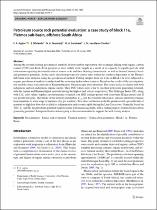| dc.contributor.author | Agbor, Fritz A. | |
| dc.contributor.author | Mhlambi, Sanelisiwe | |
| dc.contributor.author | Teumahji, N. A. | |
| dc.date.accessioned | 2023-03-28T10:00:29Z | |
| dc.date.available | 2023-03-28T10:00:29Z | |
| dc.date.issued | 2023 | |
| dc.identifier.citation | Agbor, F. A. et al. (2023). Petroleum source rock potential evaluation: A case study of block 11a, Pletmos sub‑basin, offshore South Africa. Journal of Petroleum Exploration and Production Technology, 13, 995–1007. https://doi.org/10.1007/s13202-022-01599-7 | en_US |
| dc.identifier.issn | 2190-0566 | |
| dc.identifier.uri | https://doi.org/10.1007/s13202-022-01599-7 | |
| dc.identifier.uri | http://hdl.handle.net/10566/8678 | |
| dc.description.abstract | Among the several existing geochemical methods in hydrocarbon exploration, the technique linking total organic carbon
content (TOC) and Rock–Eval pyrolysis is most widely used, largely as a result of its capacity to rapidly provide vital
information regarding the identification of source rocks and their defining characteristic, as well as thermal maturity levels
and generative potentials. In this study, data from prospective source units within the southern depocenter of the Pletmos
Sub-basin were analyzed using this geochemical method. Cutting samples from six wells in Block 11a were subjected to
organic geochemical analysis to understand the occurring hydrocarbon scenario. Based on the results of the investigation,
five notable source rock intervals of Kimmeridgian to Turonian ages were identified. The source rocks are shales with both
indigenous and non-indigenous organic matter. Their TOC values show a fair to excellent petroleum generating potential,
with the Aptian and Kimmeridgian intervals having the highest and lowest, respectively. The Hydrogen Index (HI), along
with S2/S3 ratio values, typifies a predominance of mixed type II/III (oil/gas-prone) with some type III (gas-prone) and II
(oil-prone) kerogens. The trends of the maturity parameters Tmax
and Ro (vitrinite reflectance) indicate maturities ranging
from immature to a late stage of maturity (dry gas window). Two observed breaks in the Ro profile reveal a possible link of
maturity to high heat flow that is allied to sedimentation and tectonic uplift during the Late Cretaceous. Generally, based on
TOC, S1, and HI, the petroleum potential trend increases with increasing depth, with a striking display of mixed hydrocarbon
generating potential. Interpreted hydrocarbon typing is thus recommended to support the well-testing analysis. | en_US |
| dc.language.iso | en | en_US |
| dc.publisher | Springer | en_US |
| dc.subject | Geochemistry | en_US |
| dc.subject | Thermal maturity | en_US |
| dc.subject | Hydrocarbon generation | en_US |
| dc.subject | South Africa | en_US |
| dc.subject | Petroleum | en_US |
| dc.title | Petroleum source rock potential evaluation: A case study of block 11a, Pletmos sub‑basin, offshore South Africa | en_US |
| dc.type | Article | en_US |

